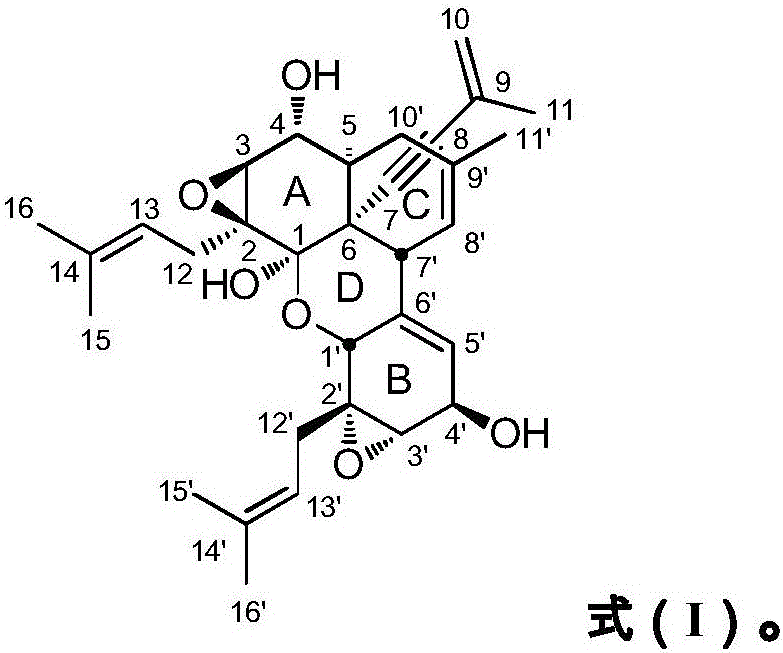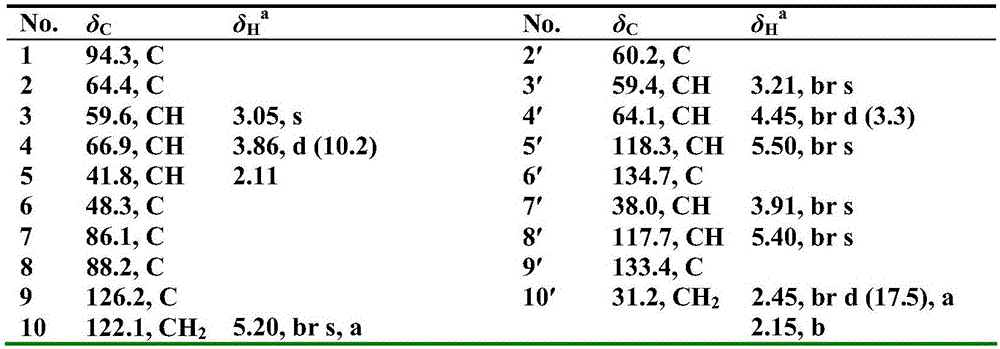Bis-poly(Biscogniauxia-enyne) A and application thereof in preparation of drugs for preventing and treating neurodegenerative diseases
A technology of dicarberene and neurodegeneration, which is applied in the fields of nervous system diseases, drug combinations, and pharmaceutical formulations, and can solve the problems of multiple donor sites and limited sources of autologous nerves, etc.
- Summary
- Abstract
- Description
- Claims
- Application Information
AI Technical Summary
Problems solved by technology
Method used
Image
Examples
Embodiment 1
[0025] Example 1 A large amount of fermentation of the fungus 71-10-1-1 of the genus Charcoa and its sample pretreatment method
[0026] (1) The fungus 71-10-1-1 of the genus Anthracum was activated on a PDA slant and then inoculated in PDB medium, at 25°C at 200r.min -1 Shake culture for 5 days to prepare seed solution, then inoculate 20 Erlenmeyer flasks with rice culture medium according to 5% inoculation amount, and culture at 25°C for 49 days to obtain fermented product. The rice medium is composed of the following components: rice 70g / bottle, purified water 105L / bottle.
[0027] (2) The fermented product was added to ethyl acetate for soaking and extraction three times, and the extract was concentrated to dryness under reduced pressure to obtain a crude extract (43.2 g).
Embodiment 2 2
[0028] The preparation of embodiment 2 dipolymer carpienyne A
[0029] The crude extract was passed through a silica gel column and eluted with cyclohexane and methanol to obtain cyclohexane part C (12.5g) and methanol part w (21.9g); then the methanol part M was subjected to medium and low pressure ODS column chromatography, followed by Four fractions (w1, w2, w3, w4) were obtained by methanol-water gradient elution with a volume ratio of 20:80, 50:50, 70:30 and 100:0; The obtained sub-fraction w3 (3.1g) was subjected to medium and low pressure liquid phase ODS column chromatography, followed by volume ratios of 20:80, 30:70, 40:60, 45:55, 50:50, 55:45, 60: 40, 100:0 methanol-water gradient elution, w3-1, w3-2, w3-3, w3-4, w3-5, w3-6, w3-7, w3-8 and w3-9 were obtained 9 subfractions. The sub-fraction w3-9 (1.5 g) obtained by eluting with methanol-water in a volume ratio of 100:0 was subjected to silica gel column chromatography, and the volume ratios were 100:0, 97:3, 95:5,...
Embodiment 3 2
[0036] Example 3 Dipolymer carpienyne A improves the learning and memory ability of senile dementia Drosophila and its activity test method
[0037] (1) Cultivation of Alzheimer's Drosophila
[0038] w 1118 (isoCJ1) was used as the control group of the experiment, the background Drosophila, abbreviated as "2U". Successful transfer into pathogenic Aβ 42 The Drosophila protein is (UAS-Aβ 42 ; abbreviated as "h29.3"). This strain of Drosophila was crossed with Drosophila expressing the Gal4 promoter in the whole brain to obtain elav-GAL4 c155 (P35) and Aβ 42 Drosophila strains.
[0039] (2) Administration of Alzheimer's Drosophila
[0040] Three groups were set up in the experiment: healthy fruit flies without drug control, diseased fruit flies without drug control and diseased fruit flies with administration.
[0041] The parents of all tested fruit flies were reared and bred in a fly house with a constant temperature of 24° C. and a constant humidity of 42% RH (Relative...
PUM
 Login to View More
Login to View More Abstract
Description
Claims
Application Information
 Login to View More
Login to View More - R&D
- Intellectual Property
- Life Sciences
- Materials
- Tech Scout
- Unparalleled Data Quality
- Higher Quality Content
- 60% Fewer Hallucinations
Browse by: Latest US Patents, China's latest patents, Technical Efficacy Thesaurus, Application Domain, Technology Topic, Popular Technical Reports.
© 2025 PatSnap. All rights reserved.Legal|Privacy policy|Modern Slavery Act Transparency Statement|Sitemap|About US| Contact US: help@patsnap.com



